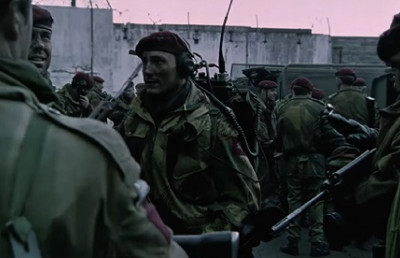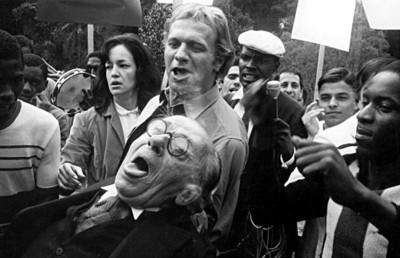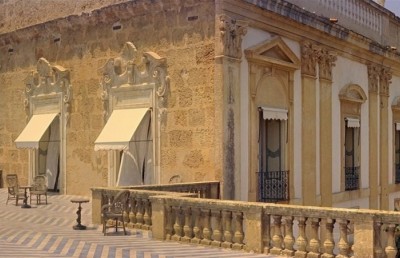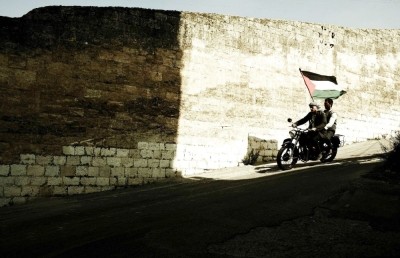Props, Things and Do the Right Thing
Overlooked Aspect of Mise en Scene
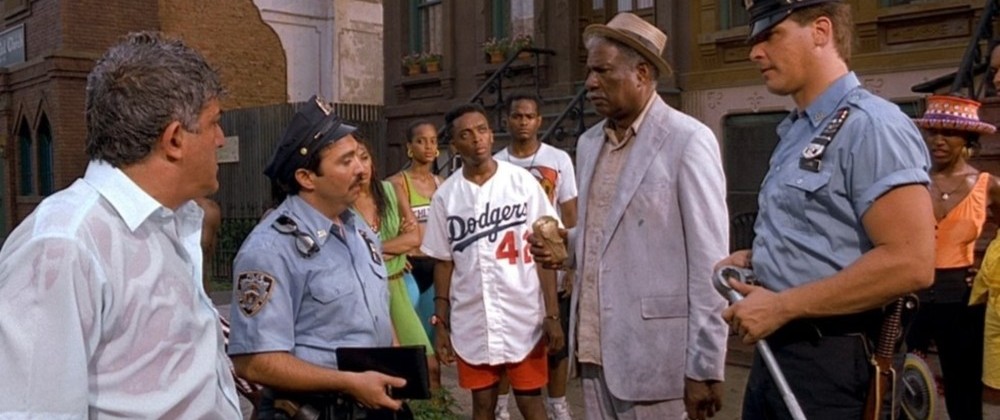
Do the Right Thing (Spike Lee, 1989) remains a highly regarded film that manages to pull social and political punches that still carry weight today, while also entertaining with its vibrant visual style, exuberant use of music and wonderful ensemble cast that starred formidable veterans (Ossie Davis, Ruby Dee), and lesser known or relatively unknown actors who would go on to more impressive careers (Danny Aiello, John Turturro, Samuel L. Jackson, Martin Lawrence, Bill Nunn, Giancarlo Esposito, and Rosie Perez). An interesting and often overlooked aspect of Do the Right Thing (and all films for that matter) is the clever use of film props. In Do the Right Thing, Spike Lee uses a preponderance of what authors Timothy Corrigan and Patricia White in their book The Film Experience refer to as metaphorical props and cultural props that help situate the film within the urban context of New York City (the Brooklyn neighbourhood of Bedford-Stuyvesant, Bed Stuy for short) circa 1989. [1]
In The Film Experience Corrigan and White write about the way different types of film props create meaning in a film’s mise en scene. They identify two general type of props, 1) Instrumental props: where objects are used according to their normal function (a gun in a western used to shoot someone, or a horse used to travel with), and 2) Metaphorical props: where those same objects are transformed into something symbolic, expressive of an inner feeling, or even something magical. For the latter they cite Gene Kelly’s umbrella in Singin’ in the rain, but you can also cite Chaplin’s cane, the black gloves in a giallo, or the brooms at the end of Miracle in Milan that the poor people use to ride off into heaven. A prop can become metaphorical, like the titular maltese falcon in The Maltese Falcon, which when finally appears at the end of the film, as a fake, is identified by Sam Spade as being “the stuff that dreams are made of.” A prop can begin as instrumental and then become metaphorical. A contemporary example comes from Drive, and the mask worn by the ‘driver’ (played by Ryan Gosling). When he first dons it in an early scene it is on the set of a film, as a stunt man about to execute a dangerous car stunt. The rubber mask is simply instrumental, either a protective wear or perhaps a likeness to the actor he is replacing. When he wears it a second time near the end of the film it is away from his work space and it becomes the centerpiece in a highly stylized moment where he tracks down “the bad guys.” The mask now has become a metaphorical signifier for the killing machine he has become, his ‘inner’ monster.
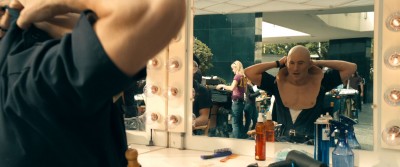
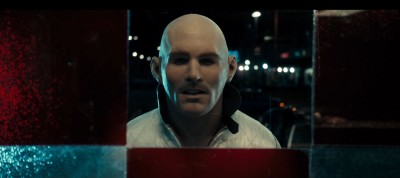
Another distinction the text makes is Cultural props: where the meaning assumed is part of a social/cultural touchstone, like the VW Beetle in Love Bug or Sleeper, and the Harley Davison motorcycle and black leather jacket in biker movies like Easy Rider (as signifiers of anti-establishment, youth counterculture, sexual revolution); or the Statue of Liberty in Planet of the Apes or Cloverfield. A final type of prop Corrigan and White identify is contextualized props where the meaning changes in the course of the film according to its use, like the violin in Red Violin or the many MacGuffin’s in Hitchcock’s films, like the uranium in Notorious.
To return to Do the Right Thing, much of the film’s referencing of both local political events (Tawana Brawly, Howard Beach, the police brutality, etc.) and broader political events are tied to Lee’s intelligent use of props (metaphorical and cultural). The film is rife with such important props, including (but not exhausting): Radio Raheem’s boombox, the pictures on Sal’s Wall of Fame (and the pictures on Mister Señor Love Daddy’s radio station wall), Mookie’s Jackie Robinson Brooklyn Dodgers baseball shirt, Smiley’s photos of Malcolm X and Martin Luther King, Da Mayor’s Miller Highlife beer cans, Buggin’ Out’s brand new white Nike Air Jordan sneakers, Radio Raheem’s LOVE-HATE brass knuckles (which are an homage to the Night of the Hunter and the words ‘Love’ ‘Hate’ written on Robert Mitchum’s knuckles), Sal’s son’s Pino and Vito’s blue-collar attire (white t-shirts, which are in stark contrast to the colourful shirts worn by most of the black characters), and last but certainly not least, Sal’s baseball bat. Over the next few pages I’d like to chart out the interconnections and meanings between these many props, paying particular attention to the importance of sport.
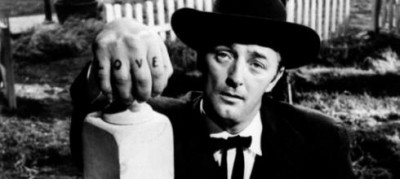
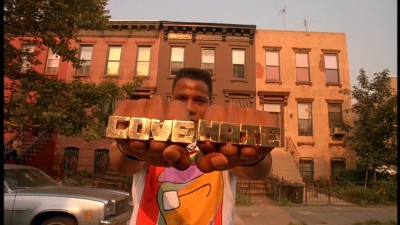
Lee’s homage to Night of the Hunter via props
Baseball, and the props used to represent it, are at the heart of much of the film’s social, cultural and political meanings. One of the key baseball props is the number 42 Jackie Robinson/Brooklyn Dodgers baseball shirt that Mookie wears for the better part of the first half of the film (in the latter part of the film, including when Mookie throws the garbage can threw Sal’s storefront window, Mookie switches over to wearing a Sal’s Famous Pizzeria work shirt). Robinson of course was not only a great player, but broke the colour barrier in 1947, becoming the first black player in the Major Leagues (up until then professional black players, Cuban, Latin American, or otherwise, played in the Negro Major Leagues, which started in the 1920s and folded one year after Robinson broke the colour barrier, in 1948). As his training ground Dodgers owner Branch Rickey had Robinson playing for the Brooklyn Dodgers farm team, the Montreal Royals, in 1946, before receiving his call up to the big leagues. Montreal then (as it still does now) may have had its share of racism, but as a Montreal Royal Robinson was enthusiastically supported by the Montreal fans. As a Montrealer I am proud of my city having played such an instrumental part in this important historical moment.
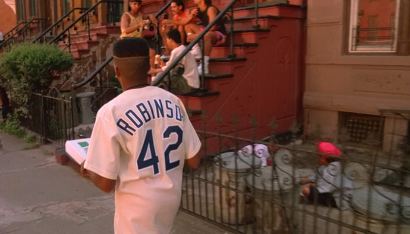
At the time of the film, black players comprised about 17% of major league players, which was down from the high of 27% in the mid-1970s. Step ahead to today, 2012, and the percentage of black ballplayers has decreased to 8.05%, “less than half the 17.25% in 1959 when the Boston Red Sox became the last team to integrate their roster.” [2] In 1975 the number was at a high of 27%, dropping to 19% in 1995. Reasons cited for the drop in black baseball players range from lack of college scholarships (compared to football and basketball), less baseball programs and leagues in inner cities, a drop in the “cool” factor of baseball, the game’s slow pace, discrimination leading to a lack of black (and Hispanic) people in management positions in baseball, etc. To make up the gap, foreign players on major league rosters has risen to 28.4% in 2012, with most of these players coming from Japan, Korea and Latin American countries. This current ethnic blend of major league baseball is actually an apt rough correlative to the ethnic mix we see prominently on display in Lee’s Do the Right Thing, where we see a handful of white characters –Sal, his two sons, Clifton, the John Savage character, Charlie, the man who drives by in his open top antique car, the two cops, the firemen at the end– while there are many African-American characters, young and old, the Puerto Rican gang of young men, along with Mookie’s Puerto Rican girlfriend, Tina and their mixed-race son Hector, and the Korean family who own the grocery store. Tellingly, Clifton is the only white person who actually lives in the community (we are not sure of the Korean family, who may live above their store).
Mookie’s Jackie Robinson shirt stands in opposition to Clifton’s (John Savage) Larry Bird Basketball Boston Celtic shirt, largely because the same city’s baseball team, the Boston Red Sox, were the last team in major league baseball to integrate a black player into their team, Pumpsie Green in 1959 (12 years after Jackie Robinson broke the colour barrier). In contrast a black character is seen wearing a Lakers basketball shirt. The other baseball prop is the New York Mets shirt worn by Mookie’s half-Puerto Rican son Hector and, to be treated later, Sal’s baseball bat. The baseball and race issue is carried over in a brief exchange between Vito (Richard Edson) and Mookie, as they argue over who is the better pitcher, the New York Mets’ Dwight Gooden (who is black) or the Boston Red Sox’s Roger Clemens (who is white). Mookie argues for Gooden, and Vito for Clemens (not forgetting the history of Boston as the last major league team to integrate).
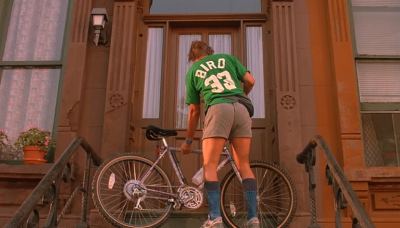
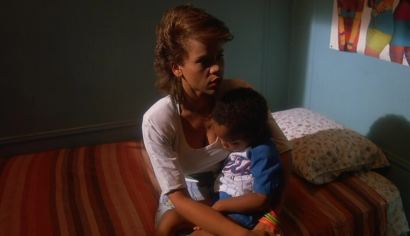
The scene where we see Clifton with his Larry Bird shirt also introduces one of the film’s cultural props, the Nike Air Jordans. The Air Jordans were launched in 1985 and became extremely popular among urban teens, even those from low income families, who would be willing to pay the inflated prize of the shoes as a signifier of coolness and street rule (there were even cases of people being beat up for their sneakers). As Clifton walks home along the sidewalk, pulling his bike alongside him, he accidentally bumps into Buggin’ Out. The casual bump has disastrous (and comical) implications for Buggin’ Out: a scuff on his pristine new Air Jordans. Goaded on by his friends, including a comical Martin Lawrence, who chides him, “You might as well throw those shits out. Those shits is broken!” Buggin’ Out angrily confronts Clifton seeking a pardon but ultimately using the altercation to raise the issue of gentrification (“Who told you to buy a brownstone in my block, in my neighbourhood, on my side of the street!”). The exorbitant cost of the sneakers is mentioned (“One hundred bucks…$108.00 with tax”). Lee is clearly poking some fun at the way people have fetishized these shoes, but Lee has a vested interest in the Air Jordans, having been integrally linked to the marketing of the shoes since the days of She’s Gotta Have it (1986), first endorsing it and then teaming up with Jordan to launch a special Lee-Jordan model, “Jordan Spiz’ike” in 2006. According to Wikipedia, “Michael Jordan and Spike Lee released the Jordan Spiz’ike shoes on October 21, 2006, as a tribute to their historic relationship. The relationship began when Mars Blackmon (a character from Spike Lee’s film, She’s Gotta Have It) became the primary pitchman in Nike commercials for Air Jordans.” [3]
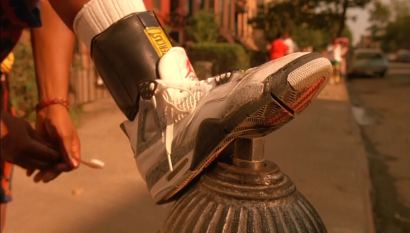
Tragedy! Scuffed Air Jordans!
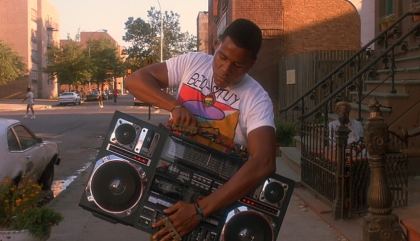
Radio Raheem’s pride
I’ll get to Sal’s baseball bat by way of another of the film’s key props, Radio Raheem’s boombox, which he carries around with him all the time, continually blaring the same song, the Public Enemy’s agit-prop rap hit, “Fight the Power.” When Buggin’ Out asks him why it’s the only song he plays, Raheem responds, “I don’t like anything else!” Although the boombox was introduced to the American market (and Japanese) in the 1970s it didn’t really pick up and become a huge selling item until the 1980s when it became associated with urban society, particularly African American and Hispanic youth. [4] And it is exactly the African American Raheem and the Puerto Rican group of young men who we see with boomboxes. The latter get into a macho game of one-upmanship with Raheem over who has the loudest box, but the puny Puerto Rican boombox is no match for Raheem’s “super jumbo” boombox, and Raheem leaves the battleground the easy winner (by contrast, the disabled Smiley sports a tiny combo cassette player/camera around his neck). But no one is more irritated by Raheem’s boombox than Sal (Danny Aiello), who rules over his “famed pizzeria” with an iron fist and a virulent sense of ownership pride. Anything and everything in his pizzeria is under his control and command. His obsessive need to control everything in his store is a combination of ultimate capitalist ownership control and old school pride of self-made enterprise (as he tells Mookie after his place is burned to the ground, he built it up from the ground bit by bit with his own hands, something Italians in particular take great pride in.) When Buggin’ Out asks Sal why there are no “brothers on the wall” Sal replies, “This is my pizzeria. American-Italians on the wall only.” (The fact checker in me says, well, not really Sal, as there are portraits of Luciano Pavorotti and Sophia Loren on the wall.) As an interesting counterpoint, which has never been, to my mind, noted, Señor Love Daddy’s comparable “wall of fame” in the radio station features only African American (or Black) singers and musical performers. When Buggin’ Out raises his voice when staking a claim for Sal to put pictures of “brothers” on his Wall of Fame, and then tosses a paper wrapper on the restaurant floor, Sal takes his bat from behind the counter and threatens Buggin’ Out with it. His son Pino takes it from his hands. Raheem’s boombox can be seen embodying qualities of both the metaphorical and cultural prop. Raheem’s boombox is a metaphorical prop because of how it represents Raheem’s identity, self-worth and sense of manhood; in a sense it is to him what the “pizzeria” is to Sal; it is a cultural prop for its association with North American hip urbanity.
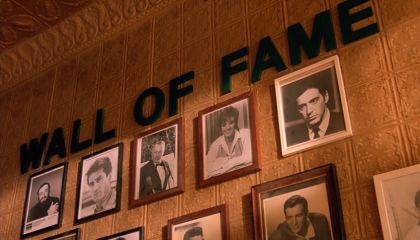
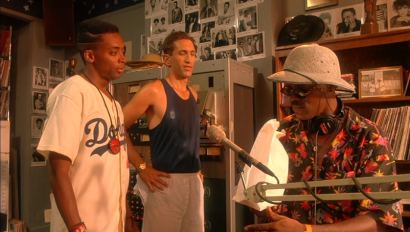
Sals’ ‘Wall of Fame” vs. Señor Love Daddy’s own unstated “wall of fame”
When Buggin’ Out returns in a much more defiant mood with Smiley and Radio Raheem’s boombox racked up to full, Sal once again takes his baseball bat out and, with the confrontation at a fever pitch, takes his anger out at Raheem’s prized boombox, smashing it to pieces. Since all of Raheem’s identity is channeled into his boombox, he retaliates by attacking Sal, and all hell breaks loose at Sal’s Pizzeria. When analyzing each prop, at one level the boombox, associated with urban, inner city, black youths, hip hop, rap, and counter-culture music, and the singular song identified with it, “Fight the Power,” stand in stark cultural opposition to the sweet as apple pie, All-American game of baseball represented by the bat. To quote a line from the ONLY song we hear repeated on the boombox, “Fight the Power,” “Elvis was a racist tried and true. Motherfuck him and John Wayne too.” In the confrontation, mainstream America destroys the radical ‘instrument’. At the end however, after the riot and subsequent fire that burns the pizzeria to the ground, there is a telling camera movement that pans screen right from a close-up of Sal’s bat burning to a close-up of Raheem’s boombox in flames, perhaps suggesting that in the end, both metaphorical props become victims of violence (could this be a nod to the Martin Luther King epitaph at the end, that refutes violence as a means to an end?).
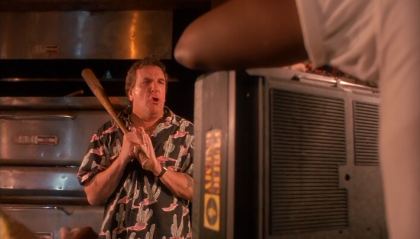
Sal defends his ‘space’ through violence

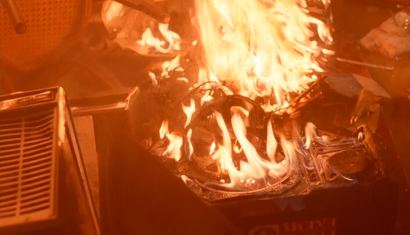
Both key props end up burned on the ground
On the other hand, during this hand held camera movement over the charred bat and boombox on the restaurant floor, we hear the song “Fight the Power,” the first time that we hear the song as non-diegetic (i.e. not sourced to the boombox). And the shot ends by panning along a pair of slowly moving feet, then up to reveal Smiley as he pins a photo of King and Malcolm X on Sal’s Wall, fulfilling Buggin’ Out’s desire to “see some brothers on the wall” (and could this in turn be seen as a nod to the Malcolm X epitaph seen at the end, where the violence does serve a point?). As in most aspects of this film, Lee suggests where he may stand on the issues, but never goes as far as imposing a dogma. The issues –and there are many, not just racism, but gentrification, generational conflict, immigration, political apathy, police racial profiling, urban youth identity– are complex and not the sort of issues that can be easily resolved in a narrative film. Do the Right Thing raises these complex issues, offers stances, but ultimately leaves them open in such a way as to instigate debate and discussion amongst its audience (something I can vouch for, having shown the film several times in my undergraduate film class, with interesting and at times heated discussion following its screening).
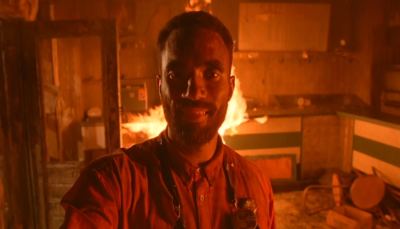
Real, or Fantasy?
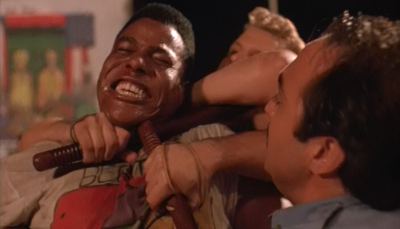
Another kind of ‘club’: police brutality
The bat as an instrument of violence has a correlative in the police night stick that the policeman uses to strangle Raheem to death. The bat has another connection to on-screen violence: as one of the mafia’s weapons of choice. In Brian De Palma’s Untouchables Robert De Niro as Al Capone uses baseball lingo and a bat to brutally murder a mafia member seated at a “company meeting”. In Martin Scorsese’s Casino the Joe Pesci character is viciously beaten to death by assailants using baseball bats. And as a student in one of my classes pointed out to me, the actor who plays Charlie, the man who drives his convertible through the neighborhood and gets it soaked, Frank Vincent, played an ill-fated character named Billy Batts in Goodfellas (and Frankie Vincent would go on to be a regular face in countless mafia and gangster/crime films).
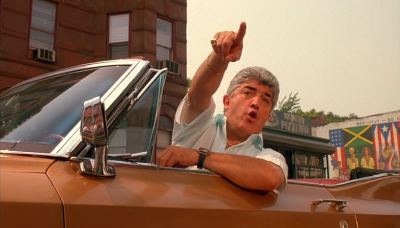
Billy Batts
In one sense the money that we see Sal and Mookie argue over in the final scene of the film is another important, if not the most important, metaphorical prop in the film. After Mookie insists on being paid his weekly salary of $250.00 Sal takes out a wad of $100.00 bills and angrily crumbles and throws the bills at Mookie (the manner in which Sal tosses them can be seen as yet again another baseball link, as he looks like a pitcher going into his wind-up and throwing a ball). In one of the film’s many forceful low angle shots we a full two shot of Mookie and Sal in profile, with the crumbled bills on the floor between them, and the garbage can that started the whole riot behind Sal, and the burned remains of the restaurant in the background. Perhaps it is also telling that for this scene (and from about the half-way point on) Mookie is wearing his work jersey, underscoring the owner/worker dynamic. As Karl Marx would say, in the end it is all about money: labor, work, capital, capitalism, careers, gentrification, ownership, responsibility (of Mookie to his child), entrepreneurship. These are all part and parcel of what the film is about. Raheem playing his too loud music inside Sal’s pizzeria is an invasion of Sal’s sense of personal property, self-worth and individual choice (he puts who he wants on his wall because it is his ‘wall of fame,’ as does Señor Love Daddy, although the difference there is that his radio station is not a public space in the same sense as Sal’s pizzeria). In the end Raheem and Sal’s two most prized material possessions are destroyed. And as harmful as the riot is to Sal’s property, the damage can never begin to compare with the loss of a human life.

Other Significant Prop Moments:
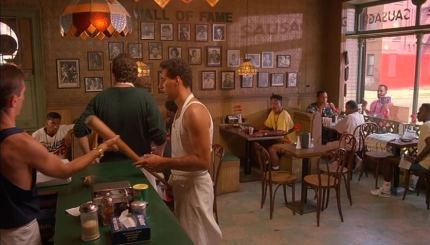
In this carefully composed shot, Lee crams in four of the film’s key props, Mookie’s Jackie Robinson shirt, Sal’s baseball bat, the photos on Sal’s wall, and Smiley’s photos of Malcolm X and Martin Luther King (outside the window).
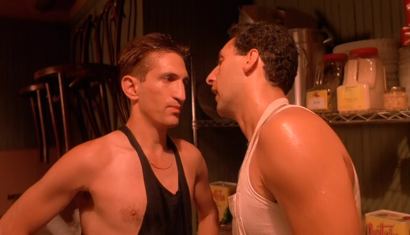
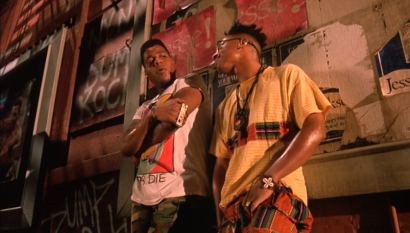
Vito and Pino’s working class clothes vs. Buggin’ Out & Raheem’s exuberant, personalized street digs
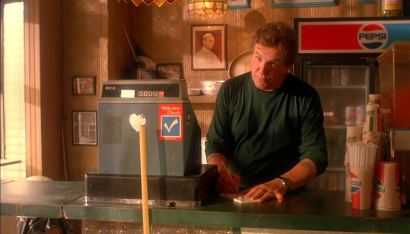
The Pope gets his own wall in Sal’s
The best single source analysis of Do the Right Thing is Ed Guerrero’s BFI Modern Classics book (BFI, Palgrave, Macmillan, 2001), especially its coverage of the film’s many allusions to real political events, to Lee’s other works, and to the broader field of Black cinema and black politics.
Endnotes
1 The Film Experience, 3rd edition, Timothy Corrigan, Patricia White, Bedford/St. Martin’s: Boston, New York, 2012, p. 72
2 Bob Nightingale, “Number of African American baseball players dips again,” USA Today, April 16, 2012
3 There is a continuity error in this scene when Clifton scuffs Buggin’ Out’s sneakers. The placement of the scuff on the right front part of the right shoe is physically impossible given how when Clifton bumps into him Buggin Out is standing with his back to him, making the position of the scuff impossible.
4 Air Jordan. Wikipedia.
5 Boombox. Wikepedia.



